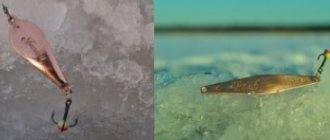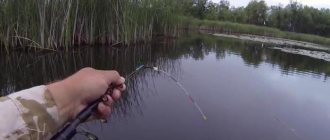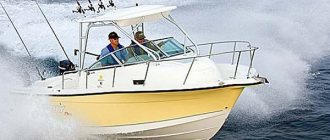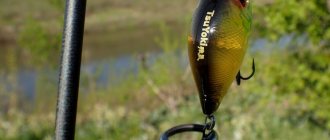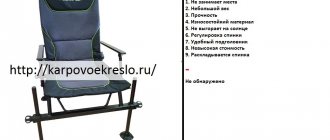Content
- 1 General information
- 2 Classification 2.1 Spoons for summer fishing 2.1.1 Oscillating spoons
- 2.1.2 Spinner
- 2.1.3 Devons
- 2.1.4 Jigs
- 2.1.5 Non-clinging lures
- 2.2.1 Sheer spoons
- 3.1 Casting a spoon
- 4.1 Color
general information
Spoons Typically, spoons are made of metal, often with an enamel surface.
To prevent the bait from being heavy, aluminum is used to make it. At the beginning of its existence, the spinner looked like a fish, its sides shiny, and it had a hook. Recently, there are often baits that do not even look like the inhabitants of reservoirs. This is explained by the fact that such spoons act as signaling devices, propagating various types of vibrations in the water column. The spoon moves in such a way that a sound wave travels through the water, to which the fish reacts. If these signals attract a particular type of fish, the chance of catching it increases dramatically.
It is best to use a spinner when hunting predatory fish. In addition to pike, perch, asp, pike perch, you can also catch large catfish. This bait is also suitable for catching some marine species of fish (siberian fish, bluefish, mullet). At the same time, the largest specimens can be caught on the lure.
Classification
Spoons can be divided into types according to various categories. For example, according to seasonality, it can be divided into summer spoons and winter spoons; by catch using spoons for perch and spoons for pike; according to the principle of operation on oscillating spoons and rotating spoons, etc. Trains of spinners (the name given to a series of spinners or spinners and other artificial baits installed one behind the other) are often used on rigs. In this case, the type of bait obtained cannot be determined. This arrangement of spinners on a tackle does not always directly increase its catchability.
For example, there are spoons whose shape is very similar to the body of a real fish. They also resemble a flat wobbler. A rotating petal is attached to this wobbler, resulting in something similar to the branded Kastmaster spinner. This bait can be supplemented with a spinner, which is a copy of a small fish with a tee. There are oscillating spoons with tees, with a lot of feathering. Such hooks look like a completely independent bait.
Lures for summer fishing
Summer lures are used for spinning fishing, with fast or slow reeling along the intended fishing spot, and with blocking the gear while moving through the reservoir (trolling).
Oscillating spoon
An oscillating spoon (oscillator) has a simple design: on a metal or other material plate, convex on one side and concave on the other, there are two holes, one for attaching to a fishing line, the second for attaching a hook. Winding rings are used to attach the fishing line and hook. Each manufacturer tries to come up with its own twist, and every year more and more new spoons appear on the market, which, according to the manufacturers, catch fish even better and even more. Nevertheless, despite the seemingly simple design and the operating principle created during the reign of Tsar Gorokh, you can catch a variety of fish using an oscillating spoon. It all depends on your ability to choose the right place for fishing, how to insert the spoon... and the presence of fish in the reservoir. A spinner is great for catching pike, and if you are planning to fish on a mountain river, a spinner should definitely be in your arsenal; it is good for catching lenok and taimen.
Spinner
A rotating spoon (spinner), which has a more complex design compared to a spinner. The spinner has a steel axis, along the edges of which winding rings for the hook and fishing line are attached, and a metal petal, and sometimes two petals, is attached to the axis itself, which, under the resistance of the water, begins to spin and make noise, attracting fish. Sometimes a weight is added to the axis to weigh down the spoon, beads are used, and other tricks are used to attract fish. Rotating spoons are available both for fishing at depth and for fishing in the middle layer of water and at the top. It all depends on the size of the petal, its shape and convexity, so when buying rotators in a store, be sure to check all the details with consultants. A rotating spoon attracts a large number of fish with its action; as a rule, it works great when catching perch, trout, grayling, rudd, and pike-perch.
Devons
Devons appeared quite a long time ago. When they appeared, all spinning anglers couldn’t get enough of this bait, which imitates a fast fish. Devon is made entirely of metal and is not small in weight. The Devon should be moved quickly, all this leads to the correct automatic hooking of the attracted fish.
Over time, the fish became more cautious. Fishermen began to modernize the Devons. The Devons became acoustic, glowing, wagging. The main disadvantage of Devon is its ability to twist the line. Even anti-twist agents of various systems do not help. The slightest malfunction in the operation of such a bait leads to significant deformation of the fishing line.
Jigs
Jigs are spoons with a cylindrical body and a tee at the end. They are used for both vertical trolling and classic casting. In this case, a “step” jig is used. Pike perch and asp are very partial to such lures. Also, pike and perch do not disdain them.
This whole classification is quite arbitrary; there are all kinds of combinations of the main types. For example, fly spoons, or spinnerbaits, which combine the petal of a classic “spinner” and a silicone worm or skirt.
Non-snagging spinners
Non-snagging spinners (non-snagging) are designed for fishing among all kinds of thickets, grass, water lilies, etc. in reservoirs. A special feature of these spinners can be considered the antennae, which are located on top of the hook and prevent it from catching on an obstacle, but if a fish takes the spinner, the antennae will bend and the fish will be hooked. The antenna can be attached both to the hook itself, which can be attached to any rotating spoon and make it non-snagging, or on the body of the spoon, as a rule, in this case the hook is single and soldered into the spoon.
Spoons for winter fishing
In the first part of the article about spinners, we learned how the spinner appeared and what types of spinners exist for summer fishing. In the second part we will talk about spinners for winter fishing, which are designed for fishing from ice. The main difference between winter and summer spoons is its structure. After all, in winter the predator is inactive and the winter spinner should attract its attention with its play. The spinner should play both when it is released freely and when it is pulled up. Often this result is achieved by shifting the center of gravity of the winter lure.
Another difference between winter spinners and summer ones is a narrower, smaller petal. For fishing at depth, some fishermen independently modify winter lures, making them heavier by filling them with lead.
Winter spinners can be divided into two main types - vertical spinners and balancers.
Sheer spoons
Sheer spoons have a narrow blade and are usually equipped with one tee at the end of the spoon; in the water the spoon is vertical. The hook on the spoon can be either soldered or suspended. Such spinners differ in their game. If you need extra play from your lure to attract fish, opt for a lure with a hanging hook. If the fish bite is persistent and you often have to remove it from the hook, a spinner with a soldered hook is ideal for these cases, which will allow you to quickly remove the fish from the hook. The size and weight of the spoon is selected based on the depth and presence of current in the reservoir, as well as the fish you want to catch.
Balancers
Balancing spoons (balancers), or as they are also called in the Far East - whitefish, are very popular among fishermen for catching all types of predatory fish in winter. Balancers come in various models, the main difference from vertical spinners is that the balancers are horizontal in the water. There are balancers with one hook, but usually there are two or more of them, one hook at the edges and a tee at the bottom in the center. The spoon imitates a fish and attracts predatory fish with its play. The color of the balancing spoon can be different and depends on the body of water and the type of fish.
Popular lures for pike
Spoons and spinners for pike fishing
Spoons and spinners are the first baits that fishermen began to use. Therefore, there is no doubt about their effectiveness. They are time-tested and very easy to use. However, it is necessary to remember about their specifics - they will be useful for fishing only if there are no obstacles on the reservoir for placing the spinner in the form of various snags and vegetation.
When choosing the size of a spoon, you need to pay attention to the time of year when the angler plans to use it. For the summer season, it is recommended to choose spinner spoons of small sizes (Meps number 1-2), and for autumn fishing you should stock up on spinners from number 3 or buy a spinner spoon for pike 8 cm long.
In order for fishing with the spoons described above to really go as the angler expects, it is necessary to correctly determine the speed of the retrieve . After all, if you move the lure too quickly, such an unpleasant phenomenon as “entering a tailspin” may occur. And then even fishing with the most catchy spoons for pike will turn out to be a waste of time.
Gallery: lures for perch and pike (25 photos)
Silicone lures for pike fishing
Many anglers often choose silicone baits, and this is no coincidence. In addition to the fact that they are very inexpensive, when used correctly, these baits can provide a very good catch. Therefore, they are perfect for beginner anglers. An important advantage of these baits is their versatility, thanks to which they can be used at any time of the year.
The range of silicone baits is very diverse. It is enough to list only a few of them - vibrotail, twister, baits in the form of worms, leeches, cuttlefish, etc. But most often, anglers choose twister and vibrotail. Even if you are good at catching fish using these lures, you shouldn’t be complacent. You should always try to change something in your technique. This refers to the way you present the bait, and then you can certainly improve your results.
We also recommend reading:
Model range of Salmo wobblers and Salmo Hornet catalog Bait for crucian carp - recipes for super bait with your own hands Spinner for pike - 10 best and how to make it yourself? Tackle and bait for fishing for carp - selection and production
Lure fishing
A complete description of lure fishing is quite often found in numerous literature on fishing. Therefore, we will touch only on certain aspects of this type of sport fishing.
Fishing with a spinning rod requires a certain amount of physical endurance from the angler, not only because of the numerous casts, but also because of long journeys along the banks of the reservoir, sometimes with overcoming hard-to-reach areas - ravines, wetlands and overgrown areas. In this case, as a rule, all the fisherman’s luggage remains behind his back in his backpack, which further increases physical activity.
The most favorable time for lure fishing is autumn, especially September, the period of the so-called “Indian summer”, on warm, quiet, cloudy or sunny days, when the leaves on the trees begin to turn yellow and cobwebs fly in the air.
On hot summer days, even in the morning dawns, it is hardly advisable to engage in lure fishing: the water is still not very clear, there are a lot of small fish swimming in it, and predators are well-fed enough to be tempted by artificial bait.
It’s a different matter in the fall, when on the eve of winter the fish begin to feed intensively, the water becomes transparent, aquatic vegetation falls to the bottom, creating good visibility for the predator, and small fish reduce their activity, no longer hiding at the bottom. Then the skillful guiding of a correctly selected spoon will undoubtedly be noticed by a predator and its grip will occur.
Casting a spinner
Casting a spoon After each cast, it is necessary to inspect the spoon and remove everything that has stuck to it when accidentally touching the bottom - grass, leaves, etc., since even small blades of grass on the spoon worsen its performance in the water.
When fishing with a spinning rod in the current, it is advisable to shift the radial (fan) casting system towards the current, that is, when casting against the current, the angle of inclination to the shoreline during the first cast should be at least 45°, and along the current - up to a cast almost parallel to the shore. In this case, when casting against the current, you should reduce the countdown of seconds for immersing the spoon to a minimum and increase the speed of the retrieve and, conversely, when casting with the current, slow down the rotation of the reel when winding up the fishing line, sometimes even stopping it if the spoon comes out close to the surface of the water. Usually, in places with fast currents, the depth of the river is small, and it is necessary, by varying the speed of rewinding the fishing line, to ensure that the spoon is still located near the bottom or in the middle layers of the water. The current of the river, as a rule, is stronger towards its middle, and the spoon is carried downstream, and the fishing line takes on an arched position, which complicates the reliability of the hook when a predator grabs the spoon. Therefore, the hook in these cases should be wide and strong, which is achieved by the appropriate span of the spinning rod.
Casting is especially effective and efficient in places where shallow water (rifts) transition to a deeper section of the river, where the bottom ledges into the depths and a strong current is formed. Predators love to hunt here, waiting for small fish to be carried away by the current. Having made a cast to the riffle, above the transition to a deep place, they reel in the spinner, carried by the current, near the ledges of the bottom, slowing down the reeling of the fishing line as the spinner moves to deep places. The grip of a predator is well determined by the spinner by the sudden stop of the fishing line and is felt like a dull blow, and sometimes even the handles of the reel jump out of the hand. When stopping the line like this, you should make a sharp, short hook with the rod. After one or two seconds, usually the fish will pull the line towards itself with reciprocal pushes, which absolutely indicates that the predator, as fishermen say, has “sat on the lure.” To be sure, it is advisable to repeat a short, energetic hook, since during the first hook, the line was not straight enough and some of its sag softened the hook, and the hook of the spoon could not fit securely into the mouth of the fish.
A few more tips for casting a spoon from an inconvenient place. If there are bushes on the bank to the right and left that do not allow you to make a regular side cast, you can cast over your head. At the same time, when sending the spinner, you must remove your finger from the reel drum exactly at the right moment, otherwise the spinner will fall nearby near the shore. Typically, a spinning player easily masters this method after several exercises on a free section of the shore. However, it is difficult to cast long-distance spinners using this method, and therefore, if the situation allows, you can cast in this place of the reservoir by climbing higher up the steep bank and sending the spoon over the bushes with a regular side cast. Then, starting the reverse winding, go down again to the coastal edge. Naturally, in the process of approaching the water, the fishing line should be reeled in a little faster in order to prevent it from sagging and the lure from lying on the bottom.
Posting the spinner
Spinner wiring diagram The wiring speed for each spinner is determined visually near the coastal zone, when the angler can observe the play of the spinner as it is retrieved.
The general rules for placing a spinner, except for catching asp on the Devon, provide for placing it near the bottom of the reservoir, but not along the bottom. By changing the reeling speed, speeding it up when the spoon touches the bottom, which is easily felt by the angler on the fishing line, and even sometimes stopping the reeling for 1-2 seconds, you can imitate the behavior of a fish and increase the chances of a predator grabbing the spoon.
Sometimes it is useful to guide the spinner with ledges, stopping reeling for 1-2 seconds, and then, slightly raising the top of the rod, continue reeling the line again. In this case, the spoon, first rising from the bottom and then falling again, imitates the swimming of live bait, which increases the chances of being caught by a predator. If there are no bites after one or two casts of the spoon, you should not immediately change the place and move on to another. If the place looks good, which the angler can determine by the external signs of fish habitat, he should repeat casts in a fan pattern, that is, sending the spoon from one place at different angles to the coastline, as well as changing the depth and nature of the spinner's movement. If a place allows, for example, a prominent coastal cape, from which it is convenient to cast, you should make such a cast along the coastline, at a distance of 5-10 m from it, trying not to catch the bottom of the spoon when reeling. Thus, the radial casting system expands significantly, which, as a rule, brings success.
Fishing
Based on the resistance of the fish, you can determine its approximate size and begin fishing for it accordingly. A thicker line when fishing with a spoon than when fishing with live bait allows you to pull the prey to the shore without much hassle and drag it through the coastal vegetation to the shore.
The fact is that when fishing with a spinning rod, the angler does not have an eyeliner, and using a short hook from the shore is not always possible. If the prey is very large, and the spinner is wearing high waders, it is advisable, after fishing and the fish is sufficiently tired, to bring it to the very shore and, entering the water, take the prey from above near the head and throw it ashore in one motion.
Gatherings of predators during fishing can occur for a number of reasons: the tee of the spoon is not sharp enough (or previously bent when hooked), dangerous jerks of the fish with an excessively stretched line, especially pike “candles”, and most often, inept pulling of the prey ashore, when the weight of the The fish are accompanied by sharp jerks on a short line. Catching a fish that has fallen off a hook in the water with your hands is a useless exercise, and the fisherman is left with grief to scold himself for his hasty actions. We repeat once again, you should never grab the fishing line with your hands when pulling fish ashore - this almost always leads to loss of prey!
Sometimes, when reeling in the spinner and suddenly stopping the line, followed by hooking the expected prey, the spinner does not feel the response jerks of the fish; the line continues to be taut. In this case, most likely the lure got caught on underwater snags. Still, you should repeat the hook and observe the position of the fishing line. Sometimes a very large pike that takes a spoon does not show any signs of life for the first few seconds, and only the movement of the fishing line against the current and its increasing tension shows that this is not a hook, but the grip of a predator.
How to lead a spinner?
The method of guiding the spinner always depends on the fish being hunted.
Perch is the most aggressive species in the reservoirs of our latitudes. He attacks everything he sees in his territory. When fishing for perch, speed and type of fishing are not so important; in this case, you need to find its parking lot.
Pike and pike perch hunt differently and it will be more difficult to interest them. When catching these fish, a uniform retrieve speed is important. The spoon should imitate the behavior of the fish, so sudden and frequent changes in the direction of movement and speed of the bait are not allowed. The spinner must rotate constantly at any depth.
We recommend: Review of a Chinese tourist burner from AliExpress. Reviews and impressions
It is important to cast the bait higher than the predator's expected location. The fall of the bait always causes fear among the inhabitants of the reservoir and the sound of the fall in the water is transmitted far away.
Most predatory fish do not attack immediately; they often follow their prey for some time. Therefore, if you lead a spoon past the place where a predator is supposed to be staying, do not stop the spoon, but move it to the side and then remove it from the water. Be prepared that a predator may attack close to the shore, at the moment you take out the bait.
Selection of spinners
Always take all your lures with you when fishing; it is impossible to know for sure what the fish will bite on today.
Color
For fishing in ponds with muddy water, you should use bait with a high level of shine. At the same time, it is important not to overdo it, using too bright spoons, which will create glare in the water and rather scare away the fish than attract them.
For fishing in clear water, an excellent solution would be matte spoons, the surface of which is detailed with fish scales.
Weight and size
The weight of the spoon is selected taking into account the depth at which the fish are most often found. For example, if the predator is closer to the bottom, the bait should have a very decent weight.
If the situation is the opposite and the fish swims near the surface, it is appropriate to use lighter spoons.
For fishing on the track, mainly spoons are used, and much less often - rotating spoons. To catch pike, use large-sized spoons, while medium-sized baits are suitable for perch.
The best lures for asp
Acme Trophy Spoon
Rating: 4.9
One of the leaders in the ranking of the best spinners is the universal Acme Trophy Spoon, equally suitable for both the summer and winter seasons. Its operating ranges are truly limitless: the model performs well in vertical trolling, trolling and various variations of stepped retrieves (jigging, twitching, stop&go). The oblong body and irregular corrugation of the front surface create a powerful luring effect that attracts even lazy predators from all over the area. With different movement options, Trophy Spoon shows a different game, which gives it weight relative to less diverse competitors.
This series has seven standard sizes, and all of them have found a response in one way or another among domestic fishermen. For asp, all the middle and highest options (T-500, T-1000 and T-340 with appropriate modifications) were the most catchy, while the smallest ones were useful for hauling perch, pike and pike perch. The only obstacle to purchasing Trophy Spoon may be the cost level, which is slightly higher than the average market (and even more so budget) limits.
Advantages
- powerful luring effect;
- a wide variety of bait sizes and colors;
- high catchability, noted by professionals;
- versatility in terms of seasonal fishing;
- original game with different wiring options.
Flaws
- high price.
DIY spinners
Any fisherman cannot help but please himself with new acquisitions for fishing, but it is worth noting that this hobby is quite expensive and for this reason many try to do it on their own in some cases. For example, you can make beautiful spoons with your own hands, which will later bring a successful catch. Let's look at some options.
One of the most popular options for spinners has become the tablespoon. To create fishing tackle from it, you need to drill two holes along the edges. After this, a ring for the fishing line is inserted into one hole, and tees into the other. This is a very high-quality bait for catching cod or pike perch. It is also often used to catch pike.
It is very important not just to make homemade spinners, but also to use your imagination and add some modifications and equipment to your product. The main point of such equipment for an oscillating spoon is the carabiner. The essence of his work is to stop the rotation of the spinner, and this detail gives it an excellent move. It is worth noting that if you have a carabiner, it becomes much easier to replace the tees and spinners on the fishing line. Regarding this point, you need to remember about choosing the right size.
Also, if you want to change the game of the spinner in a homemade spinner, you need to slightly adjust the bending angle of the petal. This can also be achieved by changing the angle of the plate itself. This work is done by weighting or trimming the side.
It is also very important not to forget when working independently on the production of spinners that the fish really loves colorful and visible details. Accordingly, to create parts with high catchability, they need to be painted. For this work, special paints or varnishes are chosen. But it is desirable that the colors are not dull and faded. Spoons polished to a shine are very popular among fishermen.
And of course, it is impossible not to mention such popular colors as silvering or gilding, as for the factory options that you can rely on when choosing a color scheme - these are red, white and black. All kinds of stripes and circles of bright colors are also welcome. So, to summarize, we can say that this work is not at all difficult, but most likely artistic and enjoyable. You can dream up your own product and the reward will be a wonderful catch thanks to your own strengths.

